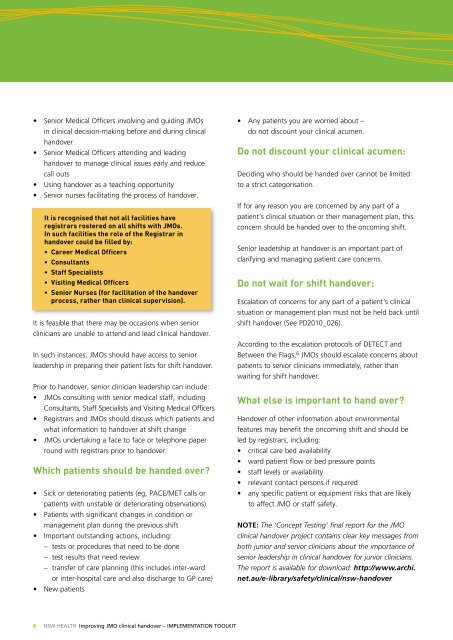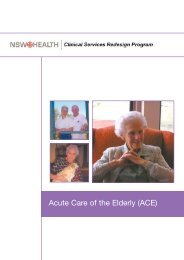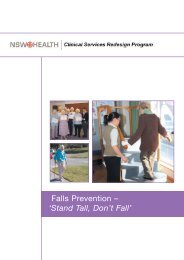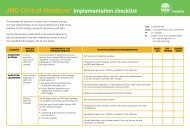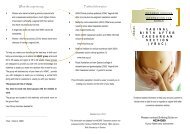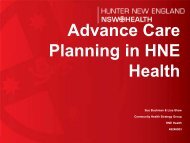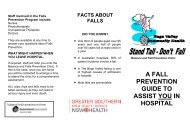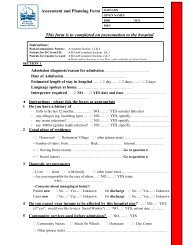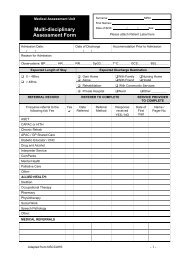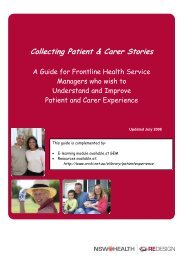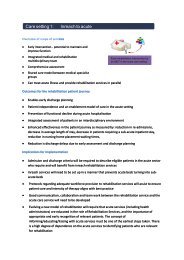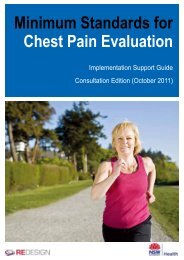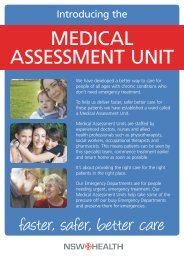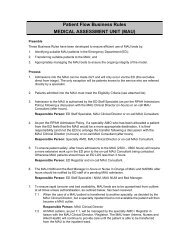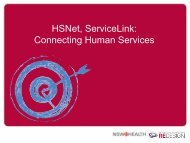Improving JMO clinical handover at all shift changes - ARCHI
Improving JMO clinical handover at all shift changes - ARCHI
Improving JMO clinical handover at all shift changes - ARCHI
Create successful ePaper yourself
Turn your PDF publications into a flip-book with our unique Google optimized e-Paper software.
• Senior Medical Officers involving and guiding <strong>JMO</strong>sin <strong>clinical</strong> decision-making before and during <strong>clinical</strong><strong>handover</strong>• Senior Medical Officers <strong>at</strong>tending and leading<strong>handover</strong> to manage <strong>clinical</strong> issues early and reducec<strong>all</strong> outs• Using <strong>handover</strong> as a teaching opportunity• Senior nurses facilit<strong>at</strong>ing the process of <strong>handover</strong>.It is recognised th<strong>at</strong> not <strong>all</strong> facilities haveregistrars rostered on <strong>all</strong> <strong>shift</strong>s with <strong>JMO</strong>s.In such facilities the role of the Registrar in<strong>handover</strong> could be filled by:• Career Medical Officers• Consultants• Staff Specialists• Visiting Medical Officers• Senior Nurses (for facilit<strong>at</strong>ion of the <strong>handover</strong>process, r<strong>at</strong>her than <strong>clinical</strong> supervision).It is feasible th<strong>at</strong> there may be occasions when seniorclinicians are unable to <strong>at</strong>tend and lead <strong>clinical</strong> <strong>handover</strong>.In such instances, <strong>JMO</strong>s should have access to seniorleadership in preparing their p<strong>at</strong>ient lists for <strong>shift</strong> <strong>handover</strong>.Prior to <strong>handover</strong>, senior clinician leadership can include:• <strong>JMO</strong>s consulting with senior medical staff, includingConsultants, Staff Specialists and Visiting Medical Officers• Registrars and <strong>JMO</strong>s should discuss which p<strong>at</strong>ients andwh<strong>at</strong> inform<strong>at</strong>ion to <strong>handover</strong> <strong>at</strong> <strong>shift</strong> change• <strong>JMO</strong>s undertaking a face to face or telephone paperround with registrars prior to <strong>handover</strong>.Which p<strong>at</strong>ients should be handed over?• Sick or deterior<strong>at</strong>ing p<strong>at</strong>ients (eg, PACE/MET c<strong>all</strong>s orp<strong>at</strong>ients with unstable or deterior<strong>at</strong>ing observ<strong>at</strong>ions)• P<strong>at</strong>ients with significant <strong>changes</strong> in condition ormanagement plan during the previous <strong>shift</strong>• Important outstanding actions, including:– tests or procedures th<strong>at</strong> need to be done– test results th<strong>at</strong> need review– transfer of care planning (this includes inter-wardor inter-hospital care and also discharge to GP care)• New p<strong>at</strong>ients• Any p<strong>at</strong>ients you are worried about –do not discount your <strong>clinical</strong> acumen.Do not discount your <strong>clinical</strong> acumen:Deciding who should be handed over cannot be limitedto a strict c<strong>at</strong>egoris<strong>at</strong>ion.If for any reason you are concerned by any part of ap<strong>at</strong>ient’s <strong>clinical</strong> situ<strong>at</strong>ion or their management plan, thisconcern should be handed over to the oncoming <strong>shift</strong>.Senior leadership <strong>at</strong> <strong>handover</strong> is an important part ofclarifying and managing p<strong>at</strong>ient care concerns.Do not wait for <strong>shift</strong> <strong>handover</strong>:Escal<strong>at</strong>ion of concerns for any part of a p<strong>at</strong>ient’s <strong>clinical</strong>situ<strong>at</strong>ion or management plan must not be held back until<strong>shift</strong> <strong>handover</strong> (See PD2010_026).According to the escal<strong>at</strong>ion protocols of DETECT andBetween the Flags, 6 <strong>JMO</strong>s should escal<strong>at</strong>e concerns aboutp<strong>at</strong>ients to senior clinicians immedi<strong>at</strong>ely, r<strong>at</strong>her thanwaiting for <strong>shift</strong> <strong>handover</strong>.Wh<strong>at</strong> else is important to hand over?Handover of other inform<strong>at</strong>ion about environmentalfe<strong>at</strong>ures may benefit the oncoming <strong>shift</strong> and should beled by registrars, including:• critical care bed availability• ward p<strong>at</strong>ient flow or bed pressure points• staff levels or availability• relevant contact persons if required• any specific p<strong>at</strong>ient or equipment risks th<strong>at</strong> are likelyto affect <strong>JMO</strong> or staff safety.NOTE: The ‘Concept Testing’ final report for the <strong>JMO</strong><strong>clinical</strong> <strong>handover</strong> project contains clear key messages fromboth junior and senior clinicians about the importance ofsenior leadership in <strong>clinical</strong> <strong>handover</strong> for junior clinicians.The report is available for download: http://www.archi.net.au/e-library/safety/<strong>clinical</strong>/nsw-<strong>handover</strong>8 NSW Health <strong>Improving</strong> <strong>JMO</strong> <strong>clinical</strong> <strong>handover</strong> – Implement<strong>at</strong>ion Toolkit


